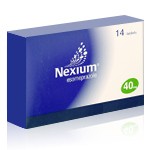Peptic Ulcer of the Stomach and Duodenum: Causes, Diagnosis, and Treatment


Peptic ulcers are open sores that develop on the inner lining of the stomach and the upper part of the small intestine, known as the duodenum. These ulcers can cause significant discomfort and, if left untreated, may lead to complications such as bleeding, perforation, and gastric obstruction. Understanding the causes, differences between stomach and duodenal ulcers, diagnostic methods, and available treatments, including the role of Nexium, is crucial for effective management of this condition.
What Causes Ulcers in the Stomach and Duodenum?
Peptic ulcers are primarily caused by an imbalance between digestive acids and the protective mucosal lining of the stomach and duodenum. The most common cause is infection with Helicobacter pylori (H. pylori), a bacterium that weakens the stomach's mucosal defense, allowing stomach acid to erode the tissue. Another major cause is the prolonged use of nonsteroidal anti-inflammatory drugs (NSAIDs), such as ibuprofen and aspirin, which reduce the production of protective prostaglandins in the stomach lining.
Other contributing factors include excessive alcohol consumption, smoking, chronic stress, and a diet high in spicy or acidic foods. While stress and diet alone do not directly cause ulcers, they can exacerbate symptoms and delay healing. In rare cases, Zollinger-Ellison syndrome, a condition characterized by excessive acid production due to gastrin-secreting tumors, can also lead to ulcer formation.
What Is the Difference Between a Stomach Ulcer and a Duodenal Ulcer?
Although both stomach ulcers (gastric ulcers) and duodenal ulcers fall under the category of peptic ulcers, they differ in terms of location, symptoms, and response to food intake. Gastric ulcers occur on the lining of the stomach, while duodenal ulcers develop in the first part of the small intestine.
Gastric ulcers often cause pain soon after eating, as food stimulates acid production, leading to irritation of the already damaged stomach lining. This pain is usually felt in the upper abdomen and may be accompanied by nausea, bloating, and a feeling of fullness. On the other hand, duodenal ulcers tend to cause pain between meals or during the night, when the stomach is empty. Eating or taking antacids often provides temporary relief, as food helps neutralize stomach acid in the duodenum.
How Is a Peptic Ulcer of the Stomach and Duodenum Diagnosed?
The diagnosis of peptic ulcers involves a combination of medical history evaluation, physical examination, and diagnostic tests. A physician typically starts by assessing symptoms and risk factors, such as NSAID use or H. pylori infection. Laboratory tests, including blood, stool, or breath tests, may be conducted to detect the presence of H. pylori.
Endoscopy is the gold standard for diagnosing peptic ulcers. This procedure involves inserting a flexible tube with a camera (endoscope) into the stomach and duodenum to visualize the ulcer and assess its severity. If necessary, a biopsy may be taken during the endoscopy to rule out malignancy or confirm H. pylori infection.
Another diagnostic tool is an upper gastrointestinal (GI) series, which involves drinking a barium solution followed by X-rays to highlight abnormalities in the stomach and duodenum. While less invasive than endoscopy, this method is not as precise in detecting small or early-stage ulcers.
What Species Causes Peptic Ulcers of the Stomach and Duodenum?
The primary microorganism responsible for peptic ulcers is Helicobacter pylori (H. pylori), a spiral-shaped bacterium that thrives in the acidic environment of the stomach. This bacterium disrupts the protective mucosal lining, making it more susceptible to acid damage. It is estimated that over half of the world's population carries H. pylori, although not all infected individuals develop ulcers.
Transmission of H. pylori occurs through direct person-to-person contact, contaminated food or water, and poor hygiene practices. While H. pylori infection alone does not always result in ulcer formation, it significantly increases the risk, especially when combined with other risk factors such as NSAID use or high acid production.
The Role of Nexium in the Treatment of Peptic Ulcers
Nexium (esomeprazole) is a proton pump inhibitor (PPI) commonly prescribed to treat peptic ulcers by reducing stomach acid production. By inhibiting the enzyme responsible for acid secretion in the stomach lining, Nexium helps promote ulcer healing and provides symptom relief.
Nexium is often used as part of a combination therapy for H. pylori-induced ulcers, alongside antibiotics such as amoxicillin and clarithromycin. This triple therapy aims to eradicate the infection while reducing acid levels to allow the ulcer to heal. In cases where ulcers are caused by NSAID use, Nexium is prescribed to minimize acid production and protect the stomach lining from further damage.
One of the key benefits of Nexium is its long-lasting effect, which provides sustained acid suppression compared to other acid-reducing medications. It is usually taken once daily before meals, and the duration of treatment varies depending on the severity of the ulcer. In most cases, significant healing occurs within 4 to 8 weeks.
While Nexium is highly effective, it is not without potential side effects. Some patients may experience headaches, nausea, diarrhea, or abdominal pain. Long-term use of PPIs has been associated with an increased risk of nutrient deficiencies, bone fractures, and gut infections due to altered stomach acidity. Therefore, it is essential to use Nexium under medical supervision and for the recommended duration.
Conclusion
Peptic ulcers of the stomach and duodenum are common but manageable conditions that result from an imbalance between digestive acids and mucosal protection. The primary causes include H. pylori infection and prolonged NSAID use, with symptoms varying depending on the ulcer's location. Diagnosis relies on a combination of clinical evaluation, laboratory tests, and endoscopy to confirm the presence of ulcers and identify underlying causes.Treatment typically involves acid suppression, infection eradication, and lifestyle modifications. Nexium plays a crucial role in managing peptic ulcers by reducing stomach acid levels, promoting healing, and providing symptom relief. While highly effective, its use should be monitored to prevent long-term complications. With proper medical intervention and adherence to treatment guidelines, most peptic ulcers can heal completely, allowing patients to regain digestive health and quality of life.
Medically Reviewed by Dr. Faride Ramos, MD
(Updated at Mar 31 / 2025)

